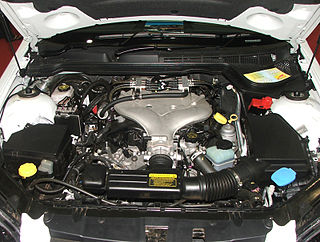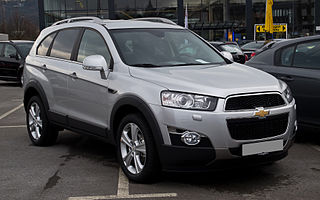
Cadillac Motor Car Division, or simply Cadillac, is a division of the American automobile manufacturer General Motors (GM) that designs and builds luxury vehicles. Its major markets are the United States, Canada and China. Cadillac models are distributed in 34 additional markets worldwide. Historically, Cadillac automobiles were at the top of the luxury field within the United States, but have been outsold by European luxury brands including BMW and Mercedes since the 2000s. In 2019, Cadillac sold 390,458 vehicles worldwide, a record for the brand.

The Saab 9-3 is a compact executive car initially developed and manufactured by the Swedish automaker Saab.

The Saab 9-5 is an executive car that was produced by the Swedish automobile maker Saab from 1997 to 2012.

Saab Automobile AB was a car manufacturer that was founded in Sweden in 1945 when its parent company, Saab AB, began a project to design a small automobile. The first production model, the Saab 92, was launched in 1949. In 1968 the parent company merged with Scania-Vabis, and ten years later the Saab 900 was launched, in time becoming Saab's best-selling model. In the mid-1980s the new Saab 9000 model also appeared.

The Cadillac CTS is a luxury car, manufactured and marketed by General Motors from 2003 until 2019 across three generations.

The GM High Feature engine is a family of modern DOHC V6 engines produced by General Motors. The series was introduced in 2004 with the Cadillac CTS and the Holden Commodore (VZ).

Theta is General Motors' automobile platform for compact/mid-size crossover SUVs. The architecture debuted in 2002 with the Saturn Vue and was later used for the Chevrolet Equinox and Captiva and similar models.

The Cadillac SRX is a mid-size luxury SUV and compact luxury crossover SUV (CUV) manufactured and marketed by Cadillac over two generations: the first generation as a five-door, three-row, seven-passenger CUV (2003–2009), and the second generation as a five-door, two-row, five-passenger CUV (2010–2016) – the latter becoming Cadillac's best selling model in the United States.

The Cadillac BLS is a compact executive car that was marketed in Europe by Cadillac, sharing General Motors' Epsilon architecture, as a restyled variant of the Saab 9-3. Development was carried out by Saab and the car was manufactured in Trollhättan, Sweden, alongside the Saab 9-3 and the Saab 9-5. Sales of the saloon began in March 2006, with an estate joining the line for 2007. Starting in 2007, the BLS was sold in the Middle East, Mexico, South Africa and South Korea.

The Opel Antara is a compact crossover SUV which was marketed by Opel from 2006 to 2015. Based on the Theta platform, the Antara closely shared its underpinnings and powertrains with the Chevrolet Captiva. However, it only offered five seats instead of seven, and features a different exterior and interior design. Sales commenced in November 2006, as the indirect successor to the Isuzu-based Frontera range.

Spyker Cars is a Dutch sports car marque held by the holding company Spyker N.V.. The modern Spyker Cars held the legal rights to the brand name. The company's motto is "Nulla tenaci invia est via", Latin for "For the tenacious, no road is impassable". The marque's logo displays an aircraft propeller superimposed over a spoked wheel, a reference to the historic Spyker company that manufactured automobiles and aircraft. In 2010, the company acquired Swedish car manufacturer Saab Automobile from General Motors.

Trollhättan Assembly is an automobile factory in Trollhättan, Sweden. The factory opened in 1947 under the ownership of Saab AB, then passing to Saab Automobile. From 1989 to 2010, the factory was partially (1989–1999), then completely (2000–2010) owned by General Motors. In 2010, Saab was sold to Spyker Cars. The plant ended production in 2011 and restarted in 2013, after the NEVS purchase of Saab Automobile. The Trollhättan complex, including the assembly, is now the sole site of all Saab engineering and manufacturing activities. After NEVS announced its closure in March 2023, the factory was sold to Stenhaga Invest AB, with both Polestar and EV Electra showing interest in buying the factory.
Chevrolet Europe GmbH was a subsidiary company of GM Korea, founded in 2005, with headquarters in Zürich, Switzerland. It provided Chevrolet brand automobiles, most of which were made in South Korea for the European market.

The Cadillac Provoq is a concept luxury crossover vehicle presented by GM on 8 January 2008, manufactured and marketed by Cadillac. It was introduced at the 2008 Consumer Electronics Show in Las Vegas, Nevada and is powered by the plug-in hybrid technology first shown in the Chevrolet Volt. For extended range, a hydrogen fuel cell will recharge the Lithium-ion battery and a solar panel will power onboard accessories, such as interior lighting and the audio system. As the Provoq concept uses a hybrid powertrain it is based on the same GM Voltec platform as the Chevrolet Volt.

Youngman was a Chinese manufacturer of buses and trucks located in Jinhua, Zhejiang province. The company was founded in 2001 by Pang Qingnian and also used to manufacture automobiles. However, its passenger car business appears to have ceased operation by mid-2015.
The Ramos Arizpe Assembly is a General Motors automobile factory in Ramos Arizpe, Coahuila, Mexico. It opened in 1981 and has manufactured Buick, Cadillac, Chevrolet, GMC, Oldsmobile, Pontiac, Saturn, and Saab vehicles. It currently produces the Chevrolet Blazer and, along with San Luis Potosi Assembly, the Chevrolet Equinox.

The Cadillac XT5 is a compact luxury / D-segment crossover SUV manufactured by General Motors. It was introduced at both the Dubai Motor Show and LA Auto Show in November 2015. The XT5 replaced the Cadillac SRX crossover when it was launched in spring 2016. It is the second model to use Cadillac's new alphanumeric naming scheme and the first in the Crossover Touring (XT) series. The XT5 is manufactured at GM's Spring Hill Manufacturing plant. The Chinese-market XT5 is manufactured in Shanghai by SAIC-GM.

The Cadillac XT4 is a subcompact luxury crossover SUV manufactured by General Motors since 2018 under the luxury Cadillac marque.

The Chevrolet TrailBlazer is a mid-size SUV produced by Chevrolet, a division of General Motors. The nameplate was first used in North America from 2001 to 2008; in 2009, it was replaced by the Traverse, as a crossover SUV. In 2011, production of a newly-redesigned version of the Trailblazer for the Asian and Brazilian markets began.



















